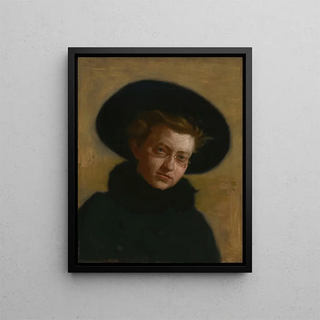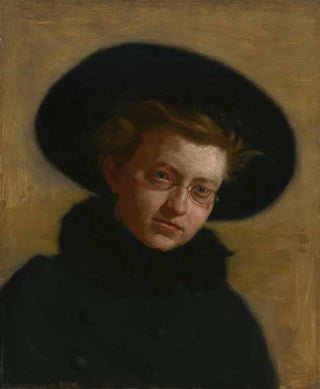Art print | Portrait of Lillian Hammit, girl with large hat - Thomas Eakins


View from behind

Frame (optional)
Portrait of Lillian Hammit, girl with a large hat - Thomas Eakins – Captivating Introduction
The "Portrait of Lillian Hammit, girl with a large hat" by Thomas Eakins is an iconic artwork that embodies the spirit of the late 19th century, a time when art aimed to be both introspective and deeply rooted in reality. Through this painting, Eakins invites us to delve into the universe of a young woman, Lillian Hammit, whose expressive face and large hat elevate the simplicity of an everyday moment to an almost mythical dimension. This portrait is not limited to a mere representation; it captures an essence, a personality, and a gaze that speak to the viewer's soul. Contemplating this work, one feels a timeless connection, an invitation to explore the depths of human psychology.
Style and uniqueness of the work
Thomas Eakins's style is distinguished by its striking realism and meticulous attention to detail. In this portrait, light plays a fundamental role, illuminating Lillian's face in a way that emphasizes her softness and inner depth. The colors, carefully chosen, create a visual harmony that draws the eye while allowing the observer to immerse themselves in the painting. The texture of the clothing, especially the large hat that crowns her head, is rendered with such precision that it seems almost tangible. Eakins does not merely reproduce his model's physical appearance; he succeeds in capturing a moment of intimacy, a human fragility that resonates with anyone who has ever felt the anxiety or beauty of existence. This portrait is an open window into Lillian's soul, revealing an emotional complexity that transcends time.
The artist and his influence
Thomas Eakins, often regarded as one of the greatest American painters, managed to blend European artistic tradition with a sensibility unique to his era. Trained in Paris, Eakins was influenced by the masters of realism, but he also incorporated elements of American culture, allowing him to develop a distinctive style. His work goes beyond mere representation; he explores themes such as truth, perception, and identity. Eakins has

Matte finish

View from behind

Frame (optional)
Portrait of Lillian Hammit, girl with a large hat - Thomas Eakins – Captivating Introduction
The "Portrait of Lillian Hammit, girl with a large hat" by Thomas Eakins is an iconic artwork that embodies the spirit of the late 19th century, a time when art aimed to be both introspective and deeply rooted in reality. Through this painting, Eakins invites us to delve into the universe of a young woman, Lillian Hammit, whose expressive face and large hat elevate the simplicity of an everyday moment to an almost mythical dimension. This portrait is not limited to a mere representation; it captures an essence, a personality, and a gaze that speak to the viewer's soul. Contemplating this work, one feels a timeless connection, an invitation to explore the depths of human psychology.
Style and uniqueness of the work
Thomas Eakins's style is distinguished by its striking realism and meticulous attention to detail. In this portrait, light plays a fundamental role, illuminating Lillian's face in a way that emphasizes her softness and inner depth. The colors, carefully chosen, create a visual harmony that draws the eye while allowing the observer to immerse themselves in the painting. The texture of the clothing, especially the large hat that crowns her head, is rendered with such precision that it seems almost tangible. Eakins does not merely reproduce his model's physical appearance; he succeeds in capturing a moment of intimacy, a human fragility that resonates with anyone who has ever felt the anxiety or beauty of existence. This portrait is an open window into Lillian's soul, revealing an emotional complexity that transcends time.
The artist and his influence
Thomas Eakins, often regarded as one of the greatest American painters, managed to blend European artistic tradition with a sensibility unique to his era. Trained in Paris, Eakins was influenced by the masters of realism, but he also incorporated elements of American culture, allowing him to develop a distinctive style. His work goes beyond mere representation; he explores themes such as truth, perception, and identity. Eakins has






